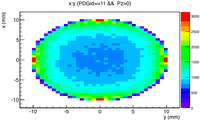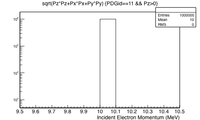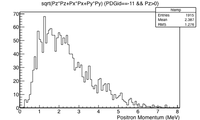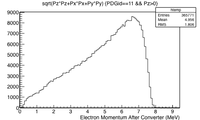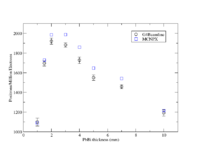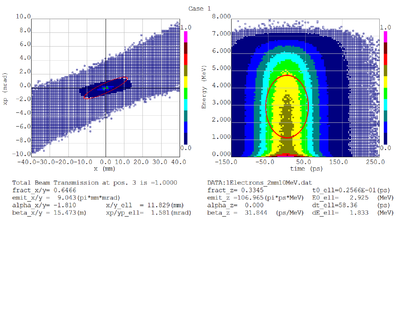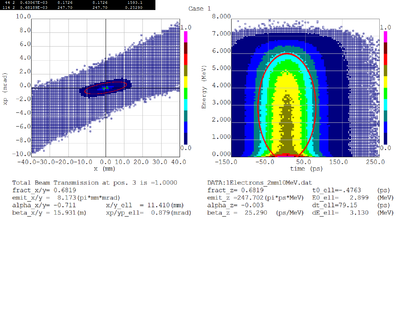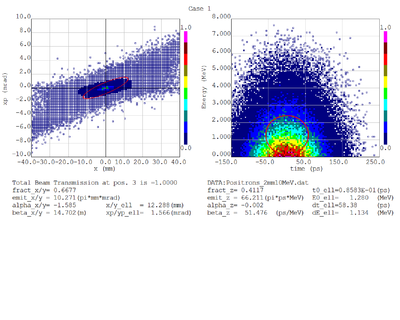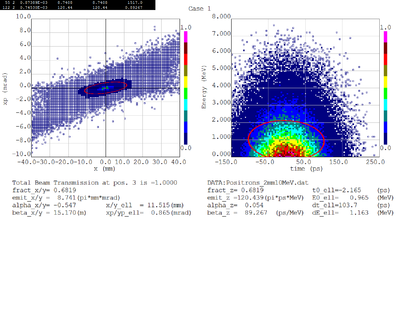Difference between revisions of "PbBi THickness CylinderBeam"
| Line 1: | Line 1: | ||
| − | |||
2mm thick PbBi, 10 MeV, 1 cm cylindrical incident electron distribution | 2mm thick PbBi, 10 MeV, 1 cm cylindrical incident electron distribution | ||
| Line 41: | Line 40: | ||
[[File:G4Bl-vs-MCNPX_5-5-2015.png| 200 px]] | [[File:G4Bl-vs-MCNPX_5-5-2015.png| 200 px]] | ||
| + | Dmitry's processing of Tony's GEANT simulations showing transverse phase space portrait (left) and longitudinal phase space portrait (right). Phase space portraits show coordinate x or y vs | ||
| + | diveregense=px/pz or py/pz (or time vs kinetic energy ). Captions show: | ||
| + | |||
| + | 1. geometric (not normalized) emittance for transverse and emittance for longitudinal phase space portraits (ellipse areas divided by "pi") | ||
| + | |||
| + | 2. Twiss parameters | ||
| + | |||
| + | 3. Ellipse centroid for longitudinal phase portrait | ||
| + | |||
| + | 4. sqrt(beta*emittance) and sqrt(gamma*emittance) - half sizes of the projections of the ellipses on the coordinate and divergence axes respectively. | ||
| + | |||
| + | Electrons - RMS | ||
| + | |||
| + | [[File:E1.png| 400 px]] | ||
| + | |||
| + | Electrons - 68.2% core | ||
| + | |||
| + | [[File:E2.png| 400 px]] | ||
| + | |||
| + | Positrons - RMS | ||
| + | |||
| + | [[File:P1.png| 400 px]] | ||
| + | |||
| + | Positrons - 68.2% core | ||
| + | |||
| + | [[File:P2.png| 400 px]] | ||
[[G4Beamline_PbBi#PbBi_THickness_CylinderBeam]] | [[G4Beamline_PbBi#PbBi_THickness_CylinderBeam]] | ||
Revision as of 17:54, 9 December 2015
2mm thick PbBi, 10 MeV, 1 cm cylindrical incident electron distribution
G4beamline pencil beam 10 cm radius
beam ellipse particle=e- nEvents=1000000 beamZ=0.0 beamX=0. beamY=0. \
sigmaX=10.0 sigmaY=10.0 sigmaXp=0.000 sigmaYp=0.000 \
meanMomentum=10. sigmaE=0. maxR=10.
Incident Electron spatial distribution and energy
Positron and Electron Momentum after the converter
| PbBi Thickness (mm) | #positrons/million electrons (G4Beamline) | #positrons/million electrons (MCNPX) |
| 1 | 1169,1083,1068,1090,1088 =1100 40 | 1091 |
| 1.5 | 1723, 1668,1671, 1687,1726=1695 28 | 1728 |
| 2 | 1902,1921,1886,1967,1922=1920 30 | 1984 |
| 3 | 1920,1880,1883,1864,1857=1881 24 | 1986 |
| 4 | 1688, 1766, 1712, 1709, 1753=1726 33 | 1858 |
| 5 | 1569,1585,1509 ,1536,1551=1550 29 | 1646 |
| 7 | 1475,1450,1457,1428,1477 =1457 20 | 1541 |
| 10 | 1250,1180,1178,1186,1166=1192 33 | 1216 |
Dmitry's processing of Tony's GEANT simulations showing transverse phase space portrait (left) and longitudinal phase space portrait (right). Phase space portraits show coordinate x or y vs diveregense=px/pz or py/pz (or time vs kinetic energy ). Captions show:
1. geometric (not normalized) emittance for transverse and emittance for longitudinal phase space portraits (ellipse areas divided by "pi")
2. Twiss parameters
3. Ellipse centroid for longitudinal phase portrait
4. sqrt(beta*emittance) and sqrt(gamma*emittance) - half sizes of the projections of the ellipses on the coordinate and divergence axes respectively.
Electrons - RMS
Electrons - 68.2% core
Positrons - RMS
Positrons - 68.2% core
